My unplanned crash and splash of Firebird Charlie model #588 into the rice paddies south of Chu Lai began a chain reaction of loss in early June 1969. Luckily for me and my crew, we were ‘on the ground’ only an hour or so before being picked up by a Rattler slick and taken first to the evac hospital in Chu Lai before returning to the 71st flight line. Some cuts and bruises, but no major injuries to anyone.
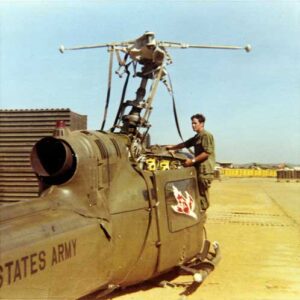
Over the next two weeks the Firebirds would lose every gunship in the platoon. All eight aircraft were either shot down, crashed, or otherwise unsalvageable due to excessive battle damage. Immediate replacements were only available at the in-country Bien Hoa depot near Saigon – 400 miles south of Chu Lai. A crew of six – four pilots and two crew members – were dispatched to deliver two replacement gunships back to Chu Lai. The most expeditious routing was hitchhiking aboard Air Force C-130s hopscotching through various airbases to the Saigon airbase at Tan Son Nhut. Night departure authorized.
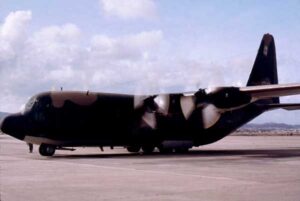
The middle of night, the middle of South Vietnam, the middle of a journey to Saigon. We began hopping aboard the Air Force’s Southeast Asia Airlines riding in C-130 transports from Chu Lai hitch-hiking short legs from airbase to airbase, catching flights to wherever that would get us to Saigon. Worse than economy class – sitting on the aircraft floor, no seat belts, no beverage service, no bag of stale peanuts. Only noise, heat, humidity, and turbine engine exhaust.
400 miles straight line flying from Chu Lai to Saigon, but that night the distance was probably doubled. We landed somewhere in the middle of the night – Quy Nhon, Tuy Hoa, Nha Trang, Phan Thiet – Nguyen Who Knows and reported to the airbase dispatch desk to inquire about further transport. On the ramp outside, a C-130 was turning & burning ready for departure. The flight dispatcher told us no one was allowed aboard that flight – it was transporting a critically injured soldier to Saigon.
The attending doctor did not want others aboard disturbing his patient. With the 130s’ rear ramp door open, we could see the doctor and a nurse lying on the aircraft floor beside the wounded soldier who had received a traumatic eye and brain wound. In the red night lights of the cargo bay, both the doc and the nurse were cradling his head between them to restrict any unnecessary movement – a wise decision by the young doctor.
The three lone passengers then departed on their night flight hoping to save the soldier’s life. Sometimes I think of that night, never knowing the fate of the wounded soldier or the heroics of the two medics. No Combat Medic Badge or Medal of Honor would be awarded to this dedicated doctor and his attending angel nurse – only the combat warriors are so rewarded.
Saigon straphangers – guys in the rear with the gear – lived large.
We eventually arrived at Tan Son Nhut by early morning – tired, dirty, hungry, and found our way to the MACV headquarters cafeteria for breakfast. In we walk, the disheveled state of soldiers searching for food other than cold C-rations. The place was Stateside – shined linoleum floors, acoustic tile ceilings, fluorescent lighting, and steam tables of freshly prepared foods.
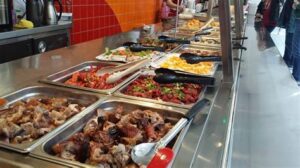
The Saigon straphangers dressed in their freshly starched and sharply creased khaki tan uniforms were aghast – who are these greasy, grungy gangsters wearing cowboy pistol belts with bullets and guns – invading our epicurean emporium. The typewriter twerps were looking at warmongers only seen and read about in daily Stars & Stripes reports. We ate and left to pick up our aircraft.
In a curious twist of fate that could be an episode from the Twilight Zone, the two Charlie models we drew from the Bien Hoa inventory were returnees to the Firebirds! Tail numbers 006 and 012 had been combat damaged with the Firebirds earlier in the war, were sent to the Army rebuild facility at Corpus Christi, Texas, and were now back home with the Firebirds! Very eerie.
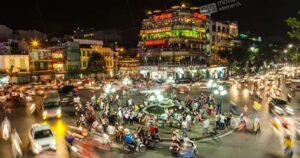
During our two day stay in the Pearl of the Orient we sampled the sights of Saigon. The guys assigned in the Saigon area lived well. The U.S. Government leased thousands of apartments, homes, and villas for the troops serving their hardship tour away from the States. No hardships here however – lots of luxury living with plenty of bars and babes, but no bamboo. These straphangers only read about the war in the Stars & Stripes newsprint. Next day we were Sigh-Gone.
Took the coastal scenic route returning to Chu Lai – following the beach and ‘feet wet’ was the expression. Near Phan Rang a war happy U.S. Air Force pilot flying an F-100 Super Saber buzzed me. Guy was close enough that I could read his call sign – Wild Thing! He zoomed by, headed to the airbase, we kept flying northward.
The summer continued with lots of heat and more enemy activity. The bad guys were everywhere in the 196th AO – constant callouts from Baldy to provide fire support for the grunts. One especially memorable fire support mission was east of LZ Baldy in the tree covered sandy beach area south of the Hoi An river. The call out from the 196th TOC was ‘troops in the open’ – an infantry ground unit had located and corralled a large concentration of bad guys inside a sparsely populated tree area. Great! We loaded flechettes rockets in addition to the normal 10 lb. High Explosive (HE) rockets and launched out of Baldy in mid-afternoon.
On station and in contact with the grunt ground commander we rolled in and unloaded on the tree area with both Flechettes and the conventional rocket HE. The Flechettes disperse their 4,600 aerodynamically shaped darts at supersonic speed – a small pink smoke puff appears when the darts launch toward the target. After several passes the ground unit moved through the area and announced over FM radio that the bad guys were found (literally) nailed to the trees. Too bad we didn’t get to see the results personally – –
Mid-morning callout for fire support and airstrike. Launch from Baldy and into the battle zone – where else? Lead Valley! More fun. Co-pilot Mike Callahan – flying along to the a/o – look over at Mike and he’s quietly ‘be-bopping’. See his head bobbing to & fro – I ask him over intercom “WTF” – no response. Look down at the radio control panel and his ‘ICS’ switch is turned off! He’s in his own world. I rapped him on his helmet, flipped his ICS switch ‘on’ and asked ‘what the hell are you doing?’ Listening to AFVN (Armed Forces Vietnam Network) radio over the ADF (automatic direction-finding radio). Pay attention! We’re enroute to an airstrike, Mike. So, I flipped up my ADF switch and this is what I heard:
Crystal Blue Persuasion – the 1969 smash hit by Tommy James & the Shondells – but it wasn’t the sun that was arisen’ most definitely – – –
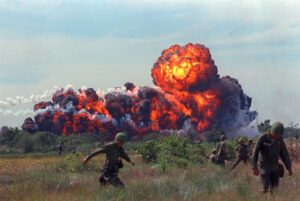
It always evokes a memory of this one hot, humid morning while delivering an air strike alongside some Marine F-4s that were dropping 750 lb. ‘high drag’ bombs into an enemy jungle position. The ADF radio was tuned to AFVN Danang, and this song played through our helmets as we attacked the same target while watching he F-4s zoom past us after dropping their high drags. Glancing outside on one pass, I watched as a huge orange/black fireball erupted from the jungle floor and observed the concentric concussion rings spread outward from the fireball through the misty morning humidity. The sun was arising most definitely that morning – with a new day coming. Every time I hear this song . . . . a new day is comin’ most definitely . . . .
The word from on high was ‘body count’ – SecDef McNamara initiated this policy while serving under Lyndon Johnson. In all bureaucracies, change is very slow to implement. And so, it was this policy continued through 1969 under Melvin Laird in the Nixon administration. The three Firebirds Fire Team Leaders (’92 – Kaz; ’97 – Kelly; ’99 – Bandito) in the Summer of ’69 formed an unspoken pact to exaggerate and inflate these ‘numbers’ on the after-action reports filed with the 71st operations center. We continued reporting body counts, structures destroyed, weapons caches blown up, etc.
The reports found their way to Americal Division, then to MACV in Saigon, the Pentagon, and eventually The White House. Who says little guys can’t influence Presidential policy? The reports and later like the War, were mostly bullshit. The AFVN radio station in Chu Lai would report daily gunships of the AMERICALdestroyed and killed enemy . . . . .we all got some great laughs knowing it was fake news!
When then President Nixon visited Vietnam on July 30, 1969, he instructed General Creighton Abrams to avoid further American casualties in offensive operations. This was called ‘protective reaction’ for troops threatened with attack. Unfortunately for both Nixon and Abrams, the NVA and the Viet Cong didn’t get the memo. What was already a terrible summer was about to become much worse in August with battles in Death Valley, Hill 102 (Million Dollar Hill), Hill 352 (where I received my last hit (12.7mm) on September 4), and Hiep Duc. The valley below LZs Center, East, West would see the bloodiest and deadliest battles ever fought in the 196th AO. The American soldiers fought for their lives in the Summer ‘69.
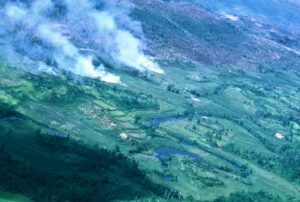
(c) Copyright – 2023 Vic Bandini